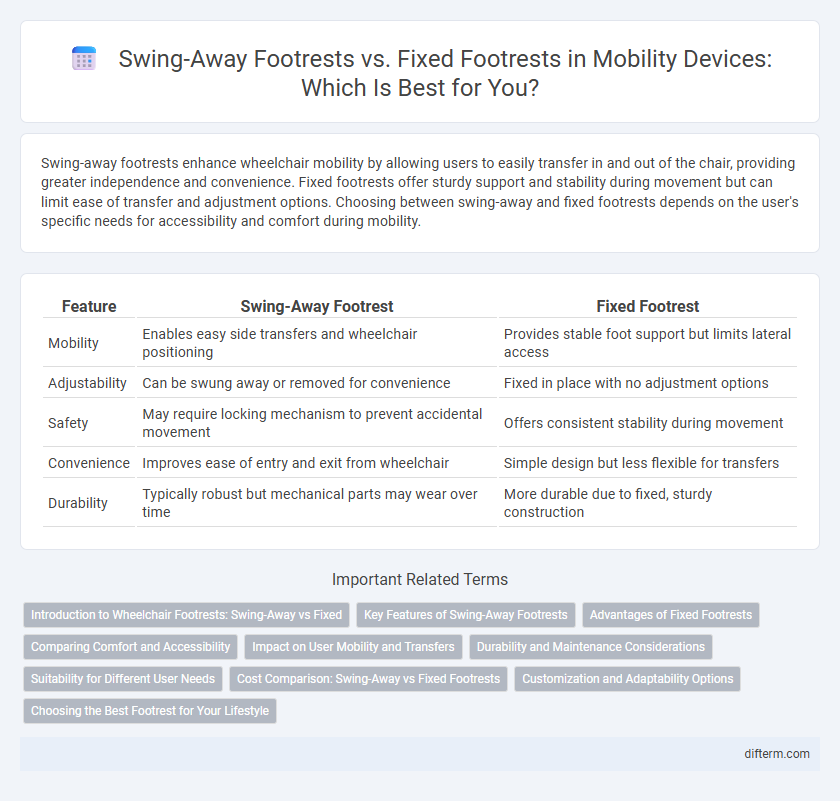Swing-away footrests enhance wheelchair mobility by allowing users to easily transfer in and out of the chair, providing greater independence and convenience. Fixed footrests offer sturdy support and stability during movement but can limit ease of transfer and adjustment options. Choosing between swing-away and fixed footrests depends on the user's specific needs for accessibility and comfort during mobility.
Table of Comparison
| Feature | Swing-Away Footrest | Fixed Footrest |
|---|---|---|
| Mobility | Enables easy side transfers and wheelchair positioning | Provides stable foot support but limits lateral access |
| Adjustability | Can be swung away or removed for convenience | Fixed in place with no adjustment options |
| Safety | May require locking mechanism to prevent accidental movement | Offers consistent stability during movement |
| Convenience | Improves ease of entry and exit from wheelchair | Simple design but less flexible for transfers |
| Durability | Typically robust but mechanical parts may wear over time | More durable due to fixed, sturdy construction |
Introduction to Wheelchair Footrests: Swing-Away vs Fixed
Swing-away footrests offer enhanced maneuverability and ease of transfer by pivoting out of the way, making them ideal for users requiring frequent repositioning or side transfers. Fixed footrests provide stable, permanent support with less adjustment, suitable for users prioritizing consistent foot support and simplicity. Selecting between swing-away and fixed footrests depends on user mobility needs, transfer frequency, and wheelchair maintenance preferences.
Key Features of Swing-Away Footrests
Swing-away footrests provide enhanced accessibility by allowing users to easily move the footrest out of the way, facilitating smoother wheelchair transfers and improved maneuverability. These footrests typically feature adjustable height and angle options, ensuring personalized comfort and ergonomic support tailored to individual needs. Constructed from lightweight yet durable materials, swing-away footrests maintain stability while offering convenient repositioning for daily mobility tasks.
Advantages of Fixed Footrests
Fixed footrests provide enhanced stability and support by maintaining a consistent foot position, reducing the risk of slips or injury during movement. They require less maintenance and offer greater durability compared to swing-away footrests, making them ideal for users needing reliable, long-term support. Fixed footrests also streamline transfers by keeping feet firmly in place, improving safety and ease of movement.
Comparing Comfort and Accessibility
Swing-away footrests offer enhanced accessibility by easily moving out of the way, making transfers in and out of mobility devices more convenient compared to fixed footrests. Fixed footrests provide consistent support and stability, which can contribute to greater comfort during prolonged use but may restrict movement and impede access. Choosing between the two depends on the user's priority for ease of access or sustained comfort during mobility.
Impact on User Mobility and Transfers
Swing-away footrests enhance user mobility by allowing easier lateral transfers and reduced obstruction during wheelchair entry and exit. Fixed footrests, while more stable, can impede smooth lateral transfers, requiring more effort and increasing transfer difficulty. Selecting swing-away footrests can significantly improve transfer efficiency and safety for wheelchair users.
Durability and Maintenance Considerations
Swing-away footrests typically offer enhanced durability due to their retractable design, which reduces exposure to wear and tear compared to fixed footrests that remain in a constant position. Maintenance for swing-away footrests often involves regular lubrication of pivot joints and hinges to ensure smooth operation, while fixed footrests require minimal upkeep but may suffer from structural fatigue over time. Material quality, such as heavy-duty steel or aluminum alloys, plays a crucial role in the longevity and maintenance frequency of both footrest types.
Suitability for Different User Needs
Swing-away footrests offer enhanced accessibility for wheelchair users who require frequent transfers, providing ease of entry and exit by folding to the side. Fixed footrests deliver stable and continuous support, ideal for users prioritizing maximum foot and leg stability during prolonged seating. Selecting between swing-away and fixed footrests depends on individual mobility levels, transfer frequency, and seating comfort preferences tailored to specific user needs.
Cost Comparison: Swing-Away vs Fixed Footrests
Swing-away footrests typically cost more than fixed footrests due to their adjustable design and added functionality, with prices ranging from $50 to $150 compared to fixed footrests which generally cost between $30 and $70. The higher upfront investment in swing-away footrests can provide enhanced mobility and convenience, potentially reducing long-term expenses related to wheelchair customization. Fixed footrests offer a budget-friendly option with fewer adjustments, making them suitable for users with straightforward needs and limited budgets.
Customization and Adaptability Options
Swing-away footrests offer enhanced customization and adaptability by allowing users to easily move or remove the footrest, accommodating transfers and varying leg positions. Fixed footrests provide a stable and consistent platform but lack the flexibility for individualized adjustments or quick repositioning. For users requiring personalized support and frequent mobility adjustments, swing-away footrests deliver superior functionality.
Choosing the Best Footrest for Your Lifestyle
Swing-away footrests offer enhanced accessibility and flexibility, making them ideal for users who frequently transfer in and out of their wheelchair. Fixed footrests provide consistent support and stability, suited for users with limited movement or those prioritizing a stationary seating position. Selecting between swing-away and fixed footrests depends on individual mobility needs, daily activities, and ease of use preferences.
Swing-away footrest vs Fixed footrest Infographic

 difterm.com
difterm.com